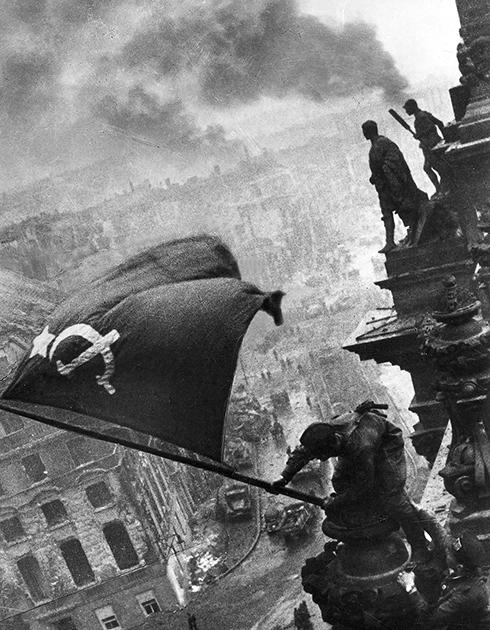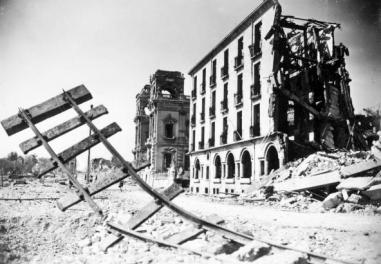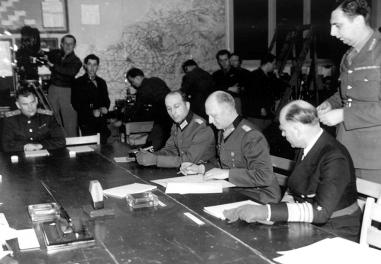The Red Army: final offensives
From the defence of Moscow to the victories of Stalingrad and Kursk, from Smolensk to the Black Sea, from the Vistula to the Oder, to the march into Berlin..., the great patriotic war conducted by the Red Army sealed the fate of the Reich heralding the emergence of a new superpower.

The search for the "decisive battle", the 'turning point', is a historians' fad, generating endless debate. Without giving in to this, everyone can agree on at least two points: Hitler lost the war well before 1945; its main military arm, the land army, was broken by the Red Army, which has 4 of the 5.3 million German military deaths in the second world war to its credit. Nevertheless, and even though the fate of the war was played out beforehand, the final offensives by the Red Army deserve to be examined in light of their military and political significance. Soviet historiography distinguishes eight operations during the first five months of 1945. Each is accomplished by all or part of two or three Fronts, which are groupings of operationally independent armies, with their air forces and comprising between 270,000 and close to 1.1 million men (1st Ukraine Front) for the strongest one. The total of all eight Fronts numbered close to 5 million men, 60 infantry armies, 6 fully motorized armoured armies, a dozen air forces, plus the Polish, Czech, Romanian and Bulgarian forces. These Fronts were globally superior in numbers as follows, 3 to 1 for infantry, 6 to 1 for tanks and over 10 to 1 for aviation and artillery.
Two groups of operations deserve special attention. The first linked the Vistula-Oder operation, which struck from Vistula to Berlin and Silesia - to wing operations in the north (East Prussia and Eastern Pomerania operations) and South (western Carpathians operation). These gigantic battering operations took place between 12 January and 25 April 1945. Their results were considerable. On the military side, they led to the destruction of 100% of the German Army Centre group and 50% of the A army group. The losses in men and equipment were so high that Hitler had to strip all the other fronts to reconstitute his forces against the Red Army. From Norway, Italy, Courland, the western borders, some 33 divisions arrived between 16 January and 20 February, 1945. In February, almost all the heavy weapons manufactured in the factories were sent east: 1,550 assault canons with just 67 going for the war in the west, 3,166 new tanks compared to 513. The first and obvious consequence is that these Soviet offensives are the main reason for the successes achieved in February and March by the Western allied armies in their march towards the Rhine. The second consequence, and an essential one for the post-war period, was that Stalin controlled 100% of Poland and 25% of Germany in March 1945.
The other major Soviet offensive concerned Hungary. The 2nd and 3rd Ukraine Fronts conducted two Hungary-related operations, the Budapest operation between 29 October 1944 and 13 February, 1945 then the Vienna operation between 16 March and 15 April, 1945, leading Hitler to throw his last SS armoured forces onto the Hungarian plains in the hope of keeping control over Hungarian and Austrian oil. These forces will be sorely missed in Berlin and the Ruhr area without however preventing Stalin from taking over 100% of Hungary and 75% of Austria.
Finally, the last two Soviet operations of the war in Europe concerned Berlin (16 April - 8 May) and Prague (6-11 May 1945). They brought the Red Army into the heart of Germany, on the Elbe, and give it control of Czechoslovakia, after the evacuation of U.S. forces from Thuringia and Western Bohemia, in accordance with the agreements concluded previously. As such, directly - through their very power- and indirectly - by facilitating the penetration of Western armies into Germany and Northern Italy - the final offensives by the Red Army appear as the major factor shaping the post-war period.
Enfin, les deux dernières opérations soviétiques de la guerre en Europe visent Berlin (16 avril-8 mai) et Prague (6-11 mai 1945). Elles amènent l'Armée rouge au cœur de l'Allemagne, sur l'Elbe, et lui donnent le contrôle de la Tchécoslovaquie, après l'évacuation des forces américaines de Thuringe et de Bohême occidentale, conformément aux accords passés antérieurement. À ce titre, directement - par leur puissance même - et indirectement – en facilitant la pénétration des armées occidentales en Allemagne et en Italie du Nord - les offensives finales de l'Armée rouge apparaissent comme le facteur majeur de modelage de l'après-guerre.
Read more
Berlin. Les offensives finales de l'Armée rouge : Vistule-Oder-Elbe, Jean Lopez, Economica, 2009.
Les cent derniers jours d'Hitler, Jean Lopez, Perrin, 2015.
Articles of the review
-
The file

The reconstruction
Disenchantment followed the days of collective joy at the time of the Liberation. France emerged bruised and battered by years of war and occupation: high toll in human lives, cities destroyed, a devastated economy and on-going rationing. Numerous challenges were now facing the country. ...Read more -
The event

Reims, May 7, 1945. The German surrender
Read more -
The interview

Serge Berstein
Former teacher at the IEP in Paris, this specialist in the political history of contemporary France looks back at the nature of the Vichy regime and sheds light on the political and institutional choices that were available to the French after the Liberation.
Read more

